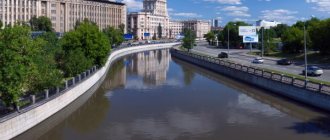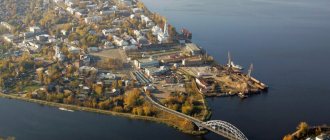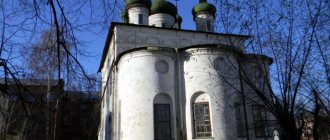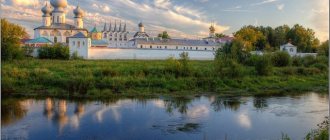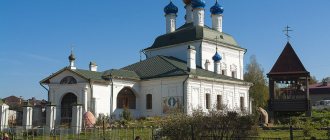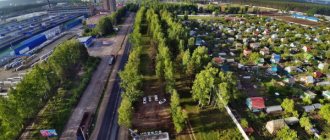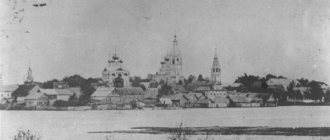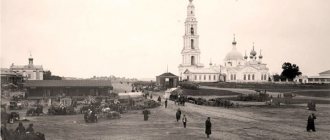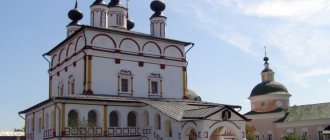Sights of Kashin (Tver region, Kashinsky district)
Kashin, one of the oldest cities in the Tver region, is not often visited by tourists, and yet it has not only an amazing natural landscape with the steep windings of the Kashinka River, but also an interesting historical and architectural heritage.
Kashin city, Tver region
Where is
Kashin, whose sights go back many hundreds of years, dates back to its first mention in the Nikon Chronicles in 1238, when it was named among the cities devastated by the Tatar-Mongol troops.
It supposedly got its name from the Kashinka river, which goes around it on all sides, and was named by the Finno-Ugric people who lived here, which means overgrown with reeds.
The city is located in the south-eastern part of the Tver region near the Moscow and Yaroslavl border, at the confluence of the Maslyatka and Vonzhi tributaries into the Kashinka River. The distance from Moscow is 180-220 km, from Tver – no more than 150 km. There is no airport in Kashin.
Getting to the city station is easy with the help of a well-established railway connection:
- A direct train from the capital's Belorussky station takes about 5 hours.
- Electric trains depart from Savelovsky station, but you will have to change trains at Sonkovo.
- Sapsan from Tver goes to Kashin in 3 hours, but ticket prices start at 1.2 thousand rubles.
You can also get to the city by bus:
- There is a direct route from Moscow Tushino via Kalyazin. Buses depart daily with 4-6 trips per day from 8 am to 6 pm on weekdays, and on weekends until 10 pm. The journey duration is about 5 hours. Ticket price is from 600 rubles.
- From Tver to the Kashin bus station there are direct bus routes 2 times a day, as well as 7 passing routes with a stop in the city.
It is very convenient to travel by private car. From the capital along a good highway through Kalyazin, the journey takes about 3 hours.
Religious buildings
Kashin merchants generously donated their rich profits for the construction of churches, and by the beginning of the last century there were more than 2 dozen Orthodox churches and 3 monasteries in the city.
Resurrection Cathedral
The architectural dominant of the city, visible from almost any part of it, is the majestic 5-domed church on the central Cathedral Square, building 1. This stone structure has survived to this day since the end of the 18th century. At that time, the cathedral could accommodate the entire city population of 7 thousand people. Anyone can visit the temple on any day of the week.
Resurrection Cathedral - the main attraction of Kashin
Nearby rises a 3-tier, 76-meter-high belfry with an observation deck, to which 125 steps lead. Entrance to the bell tower is paid, costing 100 rubles.
Ascension Cathedral
The second largest city cathedral was founded at the end of the 18th century, but its construction was completed only at the beginning of the last century. The walls of this majestic structure are decorated with ancient stucco, the interior of the temple amazes with its splendor and splendor, the elegant iconostasis and wall paintings, combined with an abundance of light, create an extraordinary atmosphere in the cathedral.
Today, restoration work continues inside the building, but on weekends ceremonial services are held here.
It is in this temple on Unity Square 1 that the holy relics of the city’s patroness, Anna Kashinskaya, are located.
Nikolaevsky Klobukov Convent
The oldest monastery of the Tver land is located in the city of Kashin on Smychka Street, house 6. The monastery was founded in the 14th century in a picturesque location on the river bank. Here the famous Russian saint Macarius of Kalyazin was tonsured a monk.
After Soviet persecution, the monastery was revived as a convent; all ancient churches and buildings are being carefully restored. The monastery is active, regular services are held in the temples, the monastery receives pilgrims and tinderboxes from all over the country. Anyone can visit the monastery on any day of the week.
Monasteries of Kashin
During Soviet times, many monasteries were practically destroyed. Only three of all the numerous monasteries have survived to this day.
On the eastern part of the town there is a functioning Nikolsky Klobukov Monastery. The buildings of the monastery have not been preserved, but the small gate church and residential building have been restored.
To the south of the city is the former Sretensky Monastery, which can be distinguished by several old dilapidated brick houses. The only thing that has survived from the monastery are residential buildings and a headless building. The only reminder of the once functioning monastery is the memorial sign, which indicates the burial of the nun.
North of the city center is the Dmitrievsky Monastery. Although it is already difficult to call these buildings a monastery. The red-brick temple was partially destroyed, but the other temple was even less fortunate - only ruins remained from it.
The most interesting museums
Kashin, whose sights are especially loved by tourists from nearby cities, offers very interesting museum exhibitions.
Porridge Museum
An unusual museum of the beloved ancient Russian dish is located on Proletarskaya Square, building 7/1, where you can get acquainted with the ancient cooking process, see various cast iron pots and pots of different times, various spoons and ladle, and also remember all the proverbs and customs associated with porridge.
There are also exhibits dedicated to gingerbread making. Interesting master classes and interactive exhibitions are held here. The museum is open to visitors every day from 11 a.m. to 5 p.m. The cost of visiting is 100 rubles, with a guide 150 rubles. per person. Children under 3 years old visit the museum for free.
Kashinsky Museum of Local Lore
A branch of the Tver State Museum in the city of Kashin on Basseynaya Square, building 5, which was opened at the beginning of the last century in the building of the former ancient Church of the Entry of the Lord into Jerusalem.
The exhibition of the modern local history museum is located in 9 halls and is presented:
- household items of peasants and city residents of different periods;
- unique ritual and religious objects;
- handicrafts of local craftsmen;
- folk costumes;
- interiors of manor rooms;
- portraits of various noble citizens;
- unique vintage photographs;
- archival documents.
The museum is open to the public from Wednesday to Sunday from 11 am to 5 pm, on Thursdays from 1 pm to 9 pm. The entrance ticket for adults is 100 rubles, for children and students – 50 rubles.
Peasant's House
The cultural center and museum is located on Lunacharsky Street 16/2 next to the main shopping area. A huge number of writers, artists, sculptors, cultural and artistic figures from all over the country visited here. You can visit it by appointment.
Today here you can see a large collection of paintings by masters of different times, an exposition of the history of icon painting, weaving craft and folk costume, and get acquainted with the collection of musical folk instruments and traditional painting.
Classes are held here for children and adults in wax modeling, felting, learning to write with a quill pen and folk painting.
Architectural and historical monuments
Cathedral of the Resurrection of Christ
The semantic and ideological center of the Kremlin was the Resurrection Cathedral (2) (1382). The Resurrection Cathedral that we see today replaced several of its predecessors, and the fate of each of them was extraordinary. So, one of them died during a strong fire. By her decree, Catherine II allocated funds for its restoration. The temple was rebuilt (1781-1787), but due to a crack that formed, they were forced to dismantle it. The new building began in 1796, successfully completed in 1804. Half a century later, an extensive refectory and a 70-meter bell tower with chimes were added to the main volume (today an observation deck is open on one of the upper tiers). The reconstruction was carried out at the expense of the winemaker, merchant of the 1st guild N. Terlikov, who did not spare 250 thousand rubles for a good cause - an amount unprecedented at that time, equal to several annual budgets of a town like Kashin. The religious building was not only luxuriously decorated inside, but also broke all records for capacity, becoming the largest in the Tver diocese. Until 1930, the Resurrection Cathedral housed the relics of the Holy Blessed Princess Anna Kashinskaya, twice canonized by the Russian Orthodox Church. Now the day of her re-canonization (June 25) is celebrated in Kashin as City Day.
Panorama of Kashin with the Resurrection Cathedral
Religious and civil architecture
The appearance of Kashin took shape at the turn of the 18th-19th centuries. In 1776 it received the status of a county town, and from 1777 it began to develop according to an approved regular plan. The straightened streets stretched strictly along the cardinal directions. By the way, their paving, albeit indirectly, was made a duty: everyone entering Kashin brought a stone with them. The face of the city was the central Moskovskaya Street. (now K. Marx) and Torgovaya Square - the best houses were built here according to exemplary designs. Standing a little away from the street. K. Marx Church of the Entrance to Jerusalem (3) (Basseinaya Square, 5) does not immediately catch your eye. The first temple on this site was built in 1401. The real Church of the Entry of the Lord into Jerusalem was built by the merchants Manukhin and Dobrynin in 1777 with their diligence and money. The temple has a quadrangle that is very elongated in height with angular blades on the sides of the cube and can be considered almost the best example of local style. Five onion-shaped heads are “dressed” in a scaly covering that imitates a ploughshare.
Shopping arcades in Kashin
Museum of Local Lore
Since 1935, the Kashin Museum of Local Lore (11.00–17.00, except Mon., Tue., (48234) 2 08 76). The museum collection contains a whole series of portraits of representatives of the local merchants, on whom the well-being of the city depended. Following the halls, you find yourself in a peasant hut, in the hall of a noble house, in a merchant's shop, in a tavern. Scenes from the past change like theatrical scenery. Photo panoramas of Kashin, captured by the famous photographer V. Kolotilshchikov, remind us of bygone antiquity.
Church of the Entrance to Jerusalem in Kashin (local history museum)
Let's go back to the street. K. Marx and head towards the center. After three blocks we turn right onto the street. Lenin. Here, among the greenery and houses, rises the Ascension Church (4) , after the transfer of the relics of Anna Kashinskaya here, it received the status of a cathedral. The religious building, founded in 1799, was rebuilt in 1850-1860. on the initiative and at the expense of N. Terlikov. From the west, a classicist bell tower designed by the provincial architect I. Lvov adjoined the refectory. What merchant city could do without shopping arcades and a guest house? Of course, in Kashin there was both. In 1822, according to the design of the architect N. Legrand, Gostiny Dvor (5) , which consisted of four buildings framed by low galleries, and several more brick shopping rows (6) . From Proletarskaya Sq. you can turn left into the alley and cross the wooden bridge (called lava in the local dialect) to the other side of Kashinka, where on a hillock stands the faceted Church of the Cross (7) (1784) - a successful combination of different styles.
Elias (Transfiguration) Church in Kashin
Returning to the other side, we will go across the road bridge to the northern part of the city. From the bridge there is a beautiful view of Kashinka, sandwiched between high banks, with two churches on either side. The closest of them - Ilyinskaya (Preobrazhenskaya) (8) (1778) - has a structure characteristic of local architecture: a high quadrangle of two lights on the basement, completed with five domes and adjacent at the ends of the altar apse and refectory with a bell tower and porch. Rich and varied decor is somewhat archaic for the 2nd floor. XVIII century For many years, the church was occupied by Tverrestavratsiya OJSC; now it has been transferred to the Russian Orthodox Church. From the Church of St. Elijah you can walk to the Church of the Nativity of Christ “on the Mountain” (9) (1784). The small, single-domed religious building today lacks a three-tiered bell tower with a sharp spire. It does not work.
Church of the Nativity "on the Mountain"
Let's return to the very center of the city to explore two merchant mansions. Residential building (10) (Proletarskaya St., ½) although modest in size, has its own highlight - a pilaster portico in the center and flowerpots in the upper part of the front facade. At an angle to it (Proletarskaya Square, 1), the mansion of the merchant-grain merchant A. Zhdanov stands out with its luxurious stucco decoration and high figured attic (11) . The house was built by capital craftsmen, who created magnificent interiors inside, which cost Zhdanov enormous expenses. The legend is still alive that the owner of the house allegedly submitted a petition to Tsar Alexander II to cover the roof with pure gold. Is this just fiction or truth? The only example of eclecticism in the city is given over to the registry office. Kashin has one more advantage - it is a balneological resort. Mineral springs have long been known here, and modern analysis has only confirmed the healing properties. With the help of carbonic-ferrous sulfuric waters, many diseases can be treated - this is being successfully done nowadays in the Kashin sanatorium.
Kashin. Klobukov Monastery
Monuments and Monuments
A very beautiful memorial statue of the patron saint of the city, Princess-nun Anna Kashinskaya, the work of the famous local sculptor Kovalchuk, was installed on Cathedral Square near the Church of the Resurrection.
Also interesting is the drinking fountain with a sculpture of cupid, installed on Sovetskaya Street at the beginning of the last century at a balneological spring that glorified the city as an ancient resort.
A memorial stone to the injured defenders of Kashin in 1609, when in an unequal battle with the army of False Dmitry, most of the city population heroically died, and the city itself was destroyed almost to the ground. The stone was installed on the day of the 600th anniversary next to the Resurrection Cathedral in memory of this historical event.
Resurrection Cathedral
In the central part of the city there is the largest five-domed Resurrection Cathedral with an apse in Tver. A little further away there is a refectory and a bell tower, consisting of three tiers. From the observation deck of the cathedral's bell tower, the beauty of the provincial town opens up for tourists. The cathedral was restored three times and its previous layout was partially restored.
Near the Resurrection Cathedral, on Cathedral Square, there is a monument to the blessed princess Anna Kashinskaya, who was not mentioned for many years. But popular veneration of the Venerable Anna resumed after miracles and signs at her tomb. In her honor, icons were painted, her life was copied, and religious processions were held.
Monument to Princess Anna Kashinskaya
There are about twenty churches in the city, although not all of them have retained their original appearance.
Thus, a pedestrian bridge across Kashinka leads to the Church of the Cross, where a Sunday school operates and services are held.
Architectural structures
The Cathedral House in the central historical part of the city is considered the oldest surviving residential building, dating back to the 3rd century. People still live in this example of provincial baroque.
Zapenin's mansion is located on Proletarskaya Street, building 7, preserved from the end of the 19th century, and is an architectural monument.
The mansion of the merchant Zhdanov with a winter garden, built in the eclectic style in the second half of the 19th century, is located on Lev Tolstoy Street.
The Shepeli estate is an architectural and park complex of a landowner's house with 2 outbuildings and outbuildings located in an old English garden with a magnificent pond.
Museum in Kashin
The collections of the city museum give an idea of the creativity of folk craftsmen. Portraits of anonymous and famous artists of the nineteenth century are very interesting. In the provincial city, pottery and blacksmithing, coinage in both copper and silver and gold, became recognized and widespread, as evidenced by the museum’s exhibitions.
Also in the museum's expositions there is a stand dedicated to the monasteries of ancient Kashin, exhibitions of folk art and goods that were produced by masters of past centuries.
Natural attractions
The Kashinka River is considered the main natural attraction, which gave the name to the city. It interestingly bends around its historical part, forming a bizarre heart shape with its curves.
The entire city is equipped with lava bridges for crossing from one high bank to another. Local craftsmen began to build them in the 19th century; many have been preserved in good condition and are used by the population for their intended purpose.
In the ancient city garden of the 18th century, located on Dukhovskaya Gora on Lev Tolstoy Street 14, there is the highest point of the city, from which a magnificent view opens.
According to local legend, the garden was planted with trees by French prisoners of Napoleonic army. There are many sculpted fairy-tale characters made of wood in the park, which children enjoy playing with. City festivals and concerts take place here.
Shopping arcades
Along the entire length of the northern wall of the monastery there are stone benches, which were built by the hands of monks back in the 19th century. These were good-quality shopping arcades with columned galleries and arcades. In the old days, trade was carried out there. To this day, shopping arcades are used for their intended purpose. It is there that fairs have been held twice a week for three centuries and handicrafts and souvenirs are sold. Rostov merchants and peasants of Borisoglebsk rented these shops and sold their goods. Today the shops have been preserved as the only evidence of the provincial life of the former volost center of the Rostov district.
Modern objects interesting to visit
Kashinsky Gostiny Dvor on Proletarskaya Square 23 is an ancient city landmark, still used for its intended purpose. The place is equipped with numerous retail outlets, where you can still buy everything you need today. In addition, colorful and noisy fairs are held here.
You can plan a vacation at the Kashin resort with healing mineral waters, which is located in the city on Sovetskaya Street. The sanatorium is equipped with modern buildings in a picturesque park with alleys and drinking fountains. Treatments with mud and mineral baths are carried out here, combining treatments with relaxing massage sessions.
Lovers of horse riding and horseback riding can visit the village of Verkhnyaya Troitsa on Central Street 1. They offer a 30-minute ride around the surrounding area in a carriage or on a sleigh for 1.5 thousand rubles. You can take a 1-hour horseback ride for 700 rubles. Or arrange a beautiful photo shoot.
Interesting places to relax with children
There are a lot of interesting places in the city to visit with children of all ages:
- Here in the city center on Proletarskaya Square 19 there is a doll museum, where more than 2 hundred unique exhibits of various toys are presented: there are ancient, special ritual, as well as porcelain figurines, Soviet period and modern dolls. The museum is open from 13 to 16-30 on weekdays. Entrance ticket costs from 30 to 50 rubles.
- The Museum of Kashin Antiquities in the village of Voznesenye, 28 km from Kashin, is made in such a way that visitors can touch all the exhibits with their hands. Here you can get acquainted with the life of a peasant hut, learn the process of baking bread and pies in a Russian oven, and processing flax. Guests are greeted by Baba Yaga and buffoons and introduced to the Firebird. Children are invited to take part in folk games and various master classes on learning traditional crafts, and will be treated to national Russian dishes. The museum is open daily from 10 a.m. to 9 p.m.
Self-guided route for 1 day
Kashin, whose sights are compactly located in the historical part of the city, is convenient to explore on your own while walking around the city.
- You can start your acquaintance with the main Cathedral Square, where the majestic Resurrection Cathedral is located.
- You should definitely climb the temple bell tower to admire the entire city from a bird's eye view.
- Not far from the temple there is a memorial sign to the defenders of the city.
- It is interesting to wander through the ancient streets of the city with ancient buildings of merchant mansions.
- It is worth admiring the beautiful monument to St. Princess Anna, the patron saint of the city, located next to the temple.
- It will be interesting to look into the unique porridge museum and buy memorable souvenirs.
- Then you can walk to the City Garden to see all the city’s surroundings from its height and wander among the centuries-old trees.
- Visit the local history museum and learn the history of the city.
- Take a stroll through the shopping arcades of Gostiny Dvor and buy interesting gifts.
- Enter the Ascension Church with the relics of the Venerable Princess Anna Kashinskaya.
- Walk along the lava bridge across the river and take extraordinary photographs.
- Visit local mineral springs, drink and wash with healing water.
- If time permits, you can go to the village of Voznesenye, where there is an interactive museum of Kashin antiquity with interesting exhibits.
- Very close to the city, at a distance of 25 km, there is the famous flooded Kalyazin bell tower.
- You can visit the ancient Nikolaevsky Klobukovsky monastery with ancient temples.
- A rich program awaits guests at the Peasant’s house, so you can set aside time to participate in some interesting master class.
- The furnishings of the Kalinin house-museum have been recreated with special care, which will delight lovers of Russian antiquity.
Historical past of the province
This town was mentioned at the beginning of the thirteenth century, it was then that it suffered greatly from the invasion of the Mongol-Tatar yoke. This is stated in the chronicle. The name of the town, according to the main version, comes from the Kashinka River, which it surrounds. The river meanders through the area so that from a bird's eye view you can see the silhouette of a heart.
Kashinka flows into the Volga River, which in those days connected Kashin with the waterway of trade, and its narrow bed complicated the approaches to the Kashin principality. At the beginning of the fourteenth century, when the city of Tver was being built, the small town served as a reliable border in the east. The chronicles often mentioned the importance of the Kashin principality, which was conquered by either the Tver or Moscow principalities. It was only at the end of the fourteenth century that it was recognized as independent.
The city was the largest trade and craft center connected with near and far lands. The masters of the principality fortified the lands of many capitals. The city minted its own coins, chronicle work was carried out, and it developed rapidly.
In the fifteenth century, Kashin became part of the Moscow state, after which its political significance became invisible. The former inheritance turned into a county with several camps and volosts, but the city did not cease to be a major church center.
Kashin disappeared from the face of the earth several times, but was constantly revived thanks to local residents who restored it, observing all the traditions of those times. In the architectural monuments of the city of Kashin you can see how local architecture has evolved. There were only about fifteen monasteries on its territory. But many were destroyed in ancient times; to our time, some monasteries have survived only in fragments.
Hotels
Kashin, whose sights can easily be explored in a day, offers guests of the city to stay at the only hotel "Rus" , which is located on Karl Marx Street 16. There is a restaurant where guests are offered breakfast in the morning. The cost of a double room with all amenities, a TV and a refrigerator will cost 1.2 thousand rubles. per day.
Another accommodation option in the city is a visit to a local sanatorium with modern buildings and 4 meals a day. Vouchers vary from 1.1 to 4.1 thousand rubles. per day. The sanatorium is located in the city on Sovetskaya Street.
Where to eat
The sights of Kashin are also famous for their Russian dishes.
At the bottom of the city, a huge pot of buckwheat porridge, with a volume of more than 1 thousand liters, was cooked, which was fed to all the guests of the holiday. This event was included in the Guinness Book of Records.
You can also grab a bite to eat at the following catering establishments:
Cafe Lilia
| Name | Address | Average bill | Kitchen features |
| Cafe Lilia | st. Karl Marx 4 | from 600 to 1.5 thousand rubles. | Dishes of Russian, Ukrainian and European cuisine |
| Restaurant Rus | st. Karl Marx 16 | from 600 to 1.5 thousand rubles. | Delicious Russian food and European cuisine |
| Cozy courtyard | st. Karl Marx 52 | from 200 to 1 thousand rubles. | Dishes of Russian and Caucasian cuisine |
| Pizzeria | Proletarskaya square, 15 | from 400 to 900 rub. | Pizza, Italian cuisine |
| Hope | st. Karl Marx 13 | from 150 to 300 rub. | Dining room |
| At Ksyusha's | st. Lunocharskogo 16/2 | from 200 rub. | Snack bar, fast food |
How to navigate
The easiest way to get around the small quiet city is on foot, especially since all the attractions are very compactly located in the historical part within walking distance of each other.
There is no city public transport here. If you need to go to another city or village, you can use regular buses departing from the bus station. You can also use taxi services. Traveling around the city costs less than 100 rubles.
The sights of the leisurely provincial Kashin allow you to plunge into the unforgettable atmosphere of Russian life in the old city, come into contact with many interesting traditions and folk customs, and guides from numerous museums will hold informative conversations and answer any questions from travelers and tourists.
Article design: Vladimir the Great
